- Home
- Carl Sagan
Shadows of Forgotten Ancestors Page 2
Shadows of Forgotten Ancestors Read online
Page 2
——
Who are we? Where do we come from? Why are we this way and not some other? What does it mean to be human? Are we capable, if need be, of fundamental change, or do the dead hands of forgotten ancestors impel us in some direction, indiscriminately for good or ill, and beyond our control? Can we alter our character? Can we improve our societies? Can we leave our children a world better than the one that was left to us? Can we free them from the demons that torment us and haunt our civilization? In the long run, are we wise enough to know what changes to make? Can we be trusted with our own future?
Many thoughtful people fear that our problems have become too big for us, that we are for reasons at the heart of human nature unable to deal with them, that we have lost our way, that the dominant political and religious ideologies are unable to halt an ominous, long-term drift in human affairs—indeed, that they have helped cause that drift through rigidity, incompetence, and the inevitable corruption of power. Is this true, and if it is, can we do anything about it?
In attempting to understand who we are, every human culture has invented a corpus of myth. The contradictions within us are ascribed to a struggle between contending but equally matched deities; or to an imperfect Creator; or, paradoxically, to a rebellious angel and the Almighty; or to the even more unequal struggle between an omnipotent being and disobedient humans. There have also been those who hold that the gods have nothing to do with it. One of them, Nanrei Kobori, late Abbot of the Temple of the Shining Dragon, a Buddhist sanctuary in Kyoto, said to us
God is an invention of Man. So the nature of God is only a shallow mystery. The deep mystery is the nature of Man.
Had life and humans first come to be hundreds or even thousands of years ago, we might know most of what’s important about our past. There might be very little of significance about our history that’s hidden from us. Our reach might extend easily to the beginning. But instead, our species is hundreds of thousands of years old, the genus Homo millions of years old, primates tens of millions of years old, mammals over 200 million years old, and life about 4 billion years old. Our written records carry us only a millionth of the way back to the origin of life. Our beginnings, the key events in our early development, are not readily accessible to us. No firsthand accounts have come down to us. They cannot be found in living memory or in the annals of our species. Our time-depth is pathetically, disturbingly shallow. The overwhelming majority of our ancestors are wholly unknown to us They have no names, no faces, no foibles. No family anecdotes attach to them. They are unreclaimable, lost to us forever. We don’t know them from Adam. If an ancestor of yours of a hundred generations ago—never mind a thousand or ten thousand—came up to you on the street with open arms, or just tapped you on the shoulder, would you return the greeting? Would you call the authorities?
We ourselves, the writers of this book, have so short a reach into our family histories that we can peer clearly only two generations back, dimly three, and almost not at all beyond that. We do not know even the names—much less the occupations, countries of origin, or personal histories—of our great-great-grandparents. Most people on Earth, we think, are similarly isolated in time. For most of us, no records have preserved the memories of our ancestors of even a few generations back.
A vast chain of beings, human and nonhuman, connects each of us with our earliest predecessors Only the most recent links are illuminated by the feeble searchlight of living memory. All the others are plunged into varying degrees of darkness, more impenetrable the farther from us they are in time. Even those fortunate families who have managed to keep meticulous records range no more than a few dozen generations into the past. And yet a hundred thousand generations ago our ancestors were still recognizably human, and ages of geological time stretch back before them. For most of us, the searchlight progresses forward as the generations do, and as the new ones are born, information about the old ones is lost. We are cut off from our past, separated from our origins, not through some amnesia or lobotomy, but because of the brevity of our lives and the immense, unfathomed vistas of time that separate us from our coming to be.
We humans are like a newborn baby left on a doorstep, with no note explaining who it is, where it came from, what hereditary cargo of attributes and disabilities it might be carrying, or who its antecedents might be. We long to see the orphan’s file.
Repeatedly, in many cultures, we invented reassuring fantasies about our parents—about how much they loved us, about how heroic and larger than life they were.3 As orphans do, we sometimes blamed ourselves for having been abandoned. It must have been our fault. We were too sinful, perhaps, or morally incorrigible. Insecure, we clung to these stories, imposing the strictest penalties on any who dared to doubt them. It was better than nothing, better than admitting our ignorance of our own origins, better than acknowledging that we had been left naked and helpless, a foundling on a doorstep.
As the infant is said to feel it is the center of its Universe, so we were once sure, not just of our central position, but that the Universe was made for us. This old, comfortable conceit, this safe view of the world has been crumbling for five centuries. The more we understood of how the world is put together, the less we needed to invoke a God or gods, and the more remote in time and causality any divine intervention had to be. The cost of coming of age is giving up the security blanket. Adolescence is a roller coaster ride.
When, beginning in 1859, our very origins, it was suggested, could be understood by a natural, unmystical process—requiring no God or gods—our aching sense of isolation became nearly complete. In the words of the anthropologist Robert Redfield, the Universe began to “lose its moral character” and became “indifferent, a system uncaring of man.”4
Moreover, without a God or gods and the attendant threat of divine punishment, will not humans be as beasts? Dostoyevsky warned that those who reject religion, however well-intentioned they may be, “will end by drenching the earth with blood.”5 Others have noted that drenching has been in progress since the dawn of civilization—and often in the name of religion.
The distasteful prospect of an indifferent Universe—or worse, a meaningless Universe—has generated fear, denial, ennui, and the sense that science is an instrument of alienation. The cold truths of our scientific age are uncongenial to many. We feel stranded and alone. We crave a purpose to give meaning to our existence. We do not want to hear that the world was not made for us. We are unimpressed with moral codes contrived by mere mortals; we want one handed down from on high. We are reluctant to acknowledge our relatives. They are strangers to us still. We feel ashamed: After imagining our Antecedent as King of the Universe, we are now asked to accept that we come from the lowest of the low—mud, and slime, and mindless beings too small to be seen with the naked eye.
Why concentrate on the past? Why upset ourselves with painful analogies between humans and beasts? Why not simply look to the future? These questions have an answer. If we do not know what we’re capable of—and not just a few celebrity saints and notorious war criminals—then we do not know what to watch out for, which human propensities to encourage, and which to guard against. Then we haven’t a clue about which proposed courses of human action are realistic, and which are impractical and dangerous sentimentality. The philosopher Mary Midgley writes,
Knowing that I have a naturally bad temper does not make me lose it On the contrary, it should help me to keep it, by forcing me to distinguish my normal peevishness from moral indignation My freedom, therefore, does not seem to be particularly threatened by the admission, nor by any light cast on the meaning of my bad temper by comparison with animals
The study of the history of life, the evolutionary process, and the nature of the other beings who ride this planet with us has begun to cast a little light on those past links in the chain. We have not met our forgotten ancestors, but we begin to sense their presence in the dark. We recognize their shadows here and there. They were once as real as we are. We would not
be here if not for them. Our natures and theirs are indissolubly linked despite the aeons that may separate us. The key to who we are is waiting in those shadows.
——
When we began this search into our origins, using the methods and findings of science, it was almost with a sense of dread. We were afraid of what we might find. We found instead not just room but reason for hope, as we begin to explain in this book.
The real orphan’s file is long. We humans have uncovered bits and pieces, occasionally a few consecutive pages, nothing as elaborate as a complete chapter. Many of the words are blurred Most have been lost.7
Here then is one version of some of the early pages of the orphan’s file, the missing note that should have accompanied the foundling on the doorstep, something of our beginnings and the forgotten ancestors that are central to the outcome of our story. Like most family stories, it begins in the dark—so long ago and far away, in circumstances so unpromising, that no one could have guessed where it all would lead.
We are about to trace the history of life, and the path that led to us—how we got to be the way we are. It is fitting that we begin at the beginning. Or a little earlier.
Chapter 1
ON EARTH AS IT IS IN HEAVEN
How long the stars
Have been fading,
Lamplight dimming …
NANSEN
(748–834, China)1
For the forming of the earth they said “Earth.” It arose suddenly, just like a cloud, like a mist, now forming, unfolding …
Popol Vuh: The Mayan Book of the Dawn of Life2
Nothing lives forever, in Heaven as it is on Earth. Even the stars grow old, decay, and die. They die, and they are born. There was once a time before the Sun and Earth existed, a time before there was day or night, long, long before there was anyone to record the Beginning for those who might come after.
Nevertheless, imagine you were a witness to that time:
An immense mass of gas and dust is swiftly collapsing under its own weight, spinning ever faster, transforming itself from a turbulent, chaotic cloud into what seems to be a distinct, orderly, thin disk. Its exact center smolders a dull, cherry red. Watch from on high, above the disk, for a hundred million years and you will see the central mass grow whiter and more brilliant, until, after a couple of abortive and incomplete attempts, it bursts into radiance, a sustained thermonuclear fire. The Sun is born. Faithfully, it will shine over the next five billion years—when the matter in the disk will have evolved into beings able to reconstruct the circumstances of its origin, and theirs.
Only the innermost provinces of the disk are illuminated. Farther out, the sunlight fails to penetrate. You plunge into the recesses of the cloud to see what wonders are unfolding. You discover a million small worlds milling about the great central fire. A few thousand sizable ones here and there, most circling near the Sun but some at great distances away, are destined to find each other, merge, and become the Earth.
This spinning disk out of which worlds are forming has fallen together from the sparse matter that punctuates a vast region of interstellar vacuum within the Milky Way galaxy. The atoms and grains that make it up are the flotsam and jetsam of galactic evolution—here, an oxygen atom generated from helium in the interior inferno of some long-dead red giant star; there, a carbon atom expelled from the atmosphere of a carbon-rich star in some quite different galactic sector; and now an iron atom freed for world-making by a mighty supernova explosion in the still more ancient past. Five billion years after the events we are describing, these very atoms may be coursing through your bloodstream.
Our story begins here in the dark, pullulating, dimly illuminated disk: the story as it actually turned out, and an enormous number of other stories that would have come to be had things gone just a little differently; the story of our world and species, but also the story of many other worlds and lifeforms destined never to be. The disk is rippling with possible futures.3
——
For most of their lives, stars shine by transmuting hydrogen into helium. It happens at enormous pressures and temperatures deep inside them. Stars have been aborning in the Milky Way galaxy for ten billion years or more—within great clouds of gas and dust. Almost all the placenta of gas and dust that once surrounded and nourished a star is quickly lost, either devoured by its tenant or spewed back into interstellar space. When they are a little older—but we are still talking about the childhood of the stars—a massive disk of gas and dust can be discerned, the inner lanes circling the star swiftly, the outer ones moving more stately and slowly. Similar disks are detectable around stars barely out of their adolescence, but now only as thin remnants of their former selves—mostly dust with almost no gas, every grain of dust a miniature planet orbiting the central star. In some of them, dark lanes, free of dust, can be made out. Perhaps half the young stars in the sky that are about as massive as the Sun have such disks. Still older stars have nothing of the sort, or at least nothing that we are yet able to detect. Our own Solar System to this day retains a very diffuse band of dust orbiting the Sun, called the zodiacal cloud, a wispy remake of the great disk from which the planets were born.
The story these observations are telling us is this: Stars formed in batches from huge clouds of gas and dust. A dense clump of material attracts adjacent gas and dust, grows larger and more massive, more efficiently draws matter to it, and is off on its way to stardom. When the temperatures and pressures in its interior become high enough, hydrogen atoms—the most abundant material in the Universe by far—rare jammed together and thermonuclear reactions are initiated. When it happens on a large enough scale, the star turns on and the nearby darkness is dispelled. Matter is turned into light.
The collapsing cloud spins up, squashes down into a disk, and lumps of matter aggregate together—successively the size of smoke particles, sand grains, rocks, boulders, mountains, and worldlets. Then the cloud tidies itself up through the simple expedient of the largest objects gravitationally consuming the debris. The dust-free lanes are the feeding zones of young planets. As the central star begins to shine, it also sends forth great gales of hydrogen that blow grains back into the void. Perhaps some other system of worlds, fated to arise billions of years later in some distant province of the Milky Way, will put these rejected building blocks to good use.
In the disks of gas and dust that surround many nearby stars, we think we see the nurseries in which worlds, far-off and exotic, are accumulating and coalescing. All over our galaxy, vast, irregular, lumpy, pitch-black, interstellar clouds are collapsing under their own gravity, and spawning stars and planets. It happens about once a month. In the observable Universe—containing as many as a hundred billion galaxies—perhaps a hundred solar systems are forming every second. In that multitude of worlds, many will be barren and desolate. Others may be lush and fertile, on which beings exquisitely adapted to their several circumstances are growing up, coming of age, and attempting to piece together their beginnings. The Universe is lavish beyond imagining.
——
As the dust settles and the disk thins, you can now make out what is happening down there. Hurtling about the Sun is a vast array of worldlets, all in slightly different orbits. Patiently you watch. Ages pass. With so many bodies moving so quickly, it is only a matter of time before worlds collide. As you look more closely, you can see collisions occurring almost everywhere. The Solar System begins amid almost unimaginable violence. Sometimes the collision is fast and head-on, and a devastating, although silent, explosion leaves nothing but shards and fragments. At other times—when two worldlets are in nearly identical orbits with nearly identical speeds—the collisions are nudging, gentle; the bodies stick together, and a bigger, double worldlet emerges.
In another age or two, you notice that several much larger bodies are growing—worlds that, by luck, escaped a disintegrating collision in their early, more vulnerable days. Such bodies—each established in its own feeding zone—plow through the
smaller worldlets and gobble them up. They have grown so large that their gravity has crushed out the irregularities; these bigger worlds are nearly perfect spheres. When a worldlet approaches a more massive body, although not close enough to collide, it swerves; its orbit is changed. On its new trajectory, it may impact some other body, perhaps smashing it to smithereens; or meet a fiery death as it falls into the young Sun, which is consuming the matter in its vicinity; or be gravitationally ejected into the frigid interstellar dark. Only a few are in fortunate orbits, neither eaten, nor pulverized, nor fried, nor exiled. They continue to grow.
Beyond a certain mass, the bigger worlds are attracting not just dust, but great streams of interplanetary gas as well. You watch them develop, eventually each with a vast atmosphere of hydrogen and helium gas surrounding a core of rock and metal. They become the four giant planets, Jupiter, Saturn, Uranus, and Neptune. You can see the characteristic banded cloud patterns emerge. Collisions of comets with their moons splay out elegant, patterned, iridescent, ephemeral rings. Pieces of an exploded world fall back together, generating a jumbled, odd-lot, motley new moon. As you watch, an Earth-sized body plows into Uranus, knocking the planet over on its side, so once each orbit its poles point straight at the distant Sun.

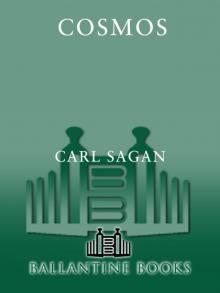 Cosmos
Cosmos Murmurs of Earth
Murmurs of Earth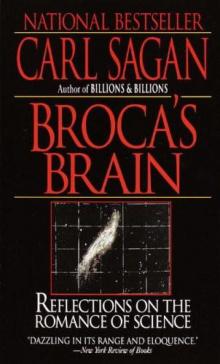 Broca's Brain
Broca's Brain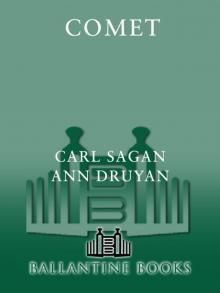 Comet
Comet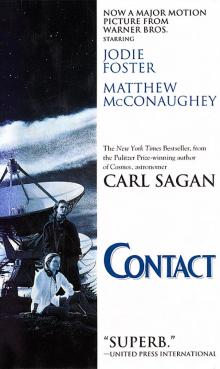 Contact
Contact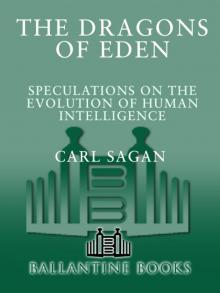 Dragons of Eden
Dragons of Eden Cosmic Connection
Cosmic Connection Shadows of Forgotten Ancestors
Shadows of Forgotten Ancestors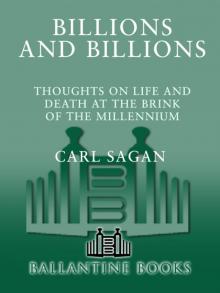 Billions & Billions
Billions & Billions Comet, Revised
Comet, Revised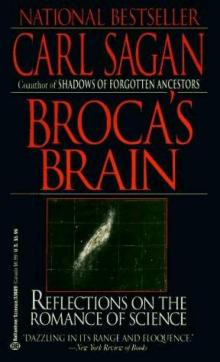 Broca's Brain: The Romance of Science
Broca's Brain: The Romance of Science The Varieties of Scientific Experience: A Personal View of the Search for God
The Varieties of Scientific Experience: A Personal View of the Search for God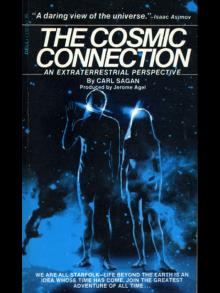 The Cosmic Connection
The Cosmic Connection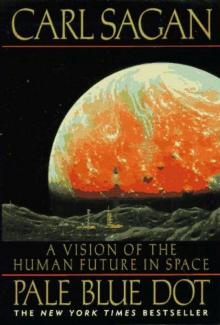 Pale Blue Dot: A Vision of the Human Future in Space
Pale Blue Dot: A Vision of the Human Future in Space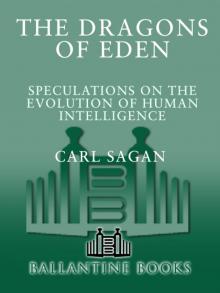 The Dragons of Eden
The Dragons of Eden